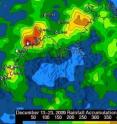NASA's TRMM satellite measures Cyclone Laurence's heavy rainfall
Tropical Cyclone Laurence dropped heavy rainfall over Northwest Australia last week, and NASA and the Japanese Space Agency's Tropical Rainfall Measuring Mission, or TRMM satellite measured that rainfall from its orbit in space. The TRMM-based, near-real time Multi-satellite Precipitation Analysis (TMPA) at the NASA Goddard Space Flight Center in Greenbelt, Md. monitors rainfall over the global Tropics. A TMPA analysis of rainfall was made during the period from December 13-23, 2009 when tropical cyclone Laurence was affecting northwest Australia.
The TMPA analysis revealed that the heaviest rainfall totals of over 450 mm (~17.72 inches) occurred in the Timor Sea near Cape Bougainville and in an area well off the coast west of Roebuck Bay in the Indian Ocean. The analysis indicates that the Australian coast had many areas along the coast where Laurence caused rainfall totals to exceed 150 mm (~5.9 inches). Laurence was briefly classified as a category 5 tropical cyclone but few people were nearby at that time.
Laurence had weakened to a category 1 tropical cyclone before making its final landfall early on December 22, 2009 (local time).
Source: NASA/Goddard Space Flight Center
Other sources
- NASA's TRMM satellite measures Cyclone Laurence's heavy rainfallfrom PhysorgMon, 4 Jan 2010, 14:35:12 UTC
